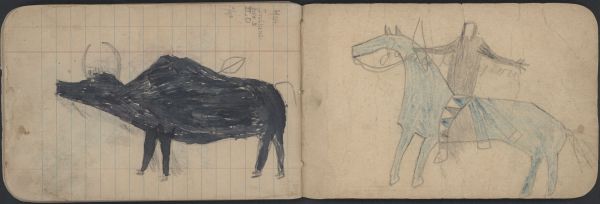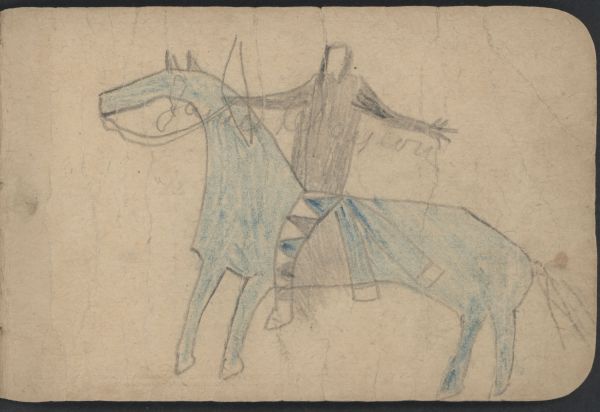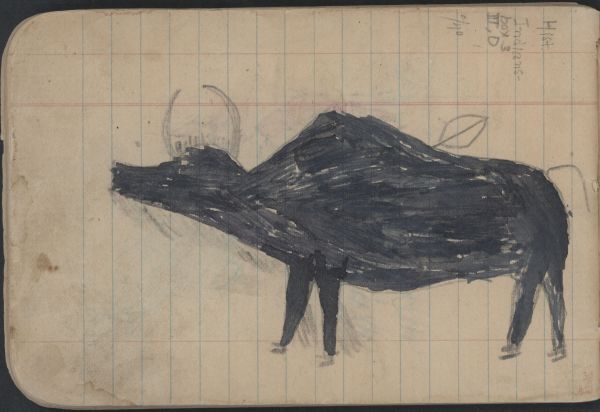HUNTING SCENE: Man on Blue Horse Hunts Buffalo
Ethnographic Notes
HUNTING SCENE. Man on Blue Horse Hunts BuffaloThis hunting scene diptych has horizontal orientation across two pages with a warrior figure on horse to the right (inside front cover) and buffalo filling the page to left. Right (inside front cover): A man sits astride a horse with arms outstretched. The name "James Clayton" is penciled in cursive (overlay) across the man's arms. Black hair, perhaps unbound, is roughly represented at shoulder length. The man's left hand has outstretched fingers. His right arm holds a bow and the horse�s reins, with no fingers visible. His shirt is dark (lead pencil fill), and it covers the torso, probably untucked in the Cheyenne fashion of the time. He wears leggings ornamented along the seam with alternating triangles of black and blue, against a white background. Two ends of the man�s blue-colored, white-edged Stroud cloth clout show. His feet appear to resemble hooves rather than moccasins of Cheyenne style. This is one of the distinctive features of all the Dodge City ledgers drawn by Wild Hog ("Hagetta" in the ledgers), Porcupine, and other Northern Cheyenne men. Candace Greene wrote Ramon Powers the following about the Kansas State Historical Society ledgers: ". . . almost all the figures� feet are hoof-like, and seldom in these ledgers are feet or moccasins drawn in normal proportion.� Gail Small, a descendant of Fort Robinson Breakout survivor Iron Teeth Woman, tells of the fleeing Northern Cheyenne people having no moccasins (Lawrence, Kansas talk at Haskell Indian Nations University, 12 August 2009). Human figures in all four ledger art notebooks associated with Wild Hog and other Northern Cheyenne prisoners in Dodge City have this characteristic of hoof-like (or bare ?) feet rather than moccasins. The pencil outlined horse is colored blue, with a loose tail and ears pricked up. Left (page 1): The buffalo image is outlined in lead pencil and filled with black ink. The buffalo faces away from the warrior. An arrow shaft is visible entering behind the hump, buried to the feather fletching. The animal has prominent horns and shaggy fringe drawn in pencil between horns, on the lower jaw and front legs. Its hooves are drawn in some detail to show the characteristic cloven or two toes an even-toed ungulate of the order Artiodactyla. Kansas State Library information is penciled into the upper left-hand corner: �Hist./ Indians-/ Cheyenne / c 40.� The dominant hunter is on the right-hand page, from the viewer�s perspective, and the action moves from right to left. Candace Greene describes the syntax of Cheyenne ledger art as moving, most often, from the dominant right-hand side to the left-hand side, described in her article "Structure and Meaning in Cheyenne Ledger Art" (Plains Indian Drawings 1865-1935, ed. Janet Catherine Berlo, New York: Abrams, 1996: 34-9). In her dissertation, she explains the typical bilateral composition of "the majority of Cheyenne pictures� (1985: 67). The two elements contrast: Cheyenne/ enemy; victor/vanquished; hunter/prey; man/woman (Greene 1985: 67-73). Another characteristic of this highly connotative sign system is simultaneity: "Every figure fills a number of categories simultaneously (male, Cheyenne, warrior, shield bearer, etc.), and our attention is brought to bear upon a particular one only by contrast with the other figure in the picture" (Greene, 1985: 67). Media: pencil, colored pencil, pen and ink



Denise Low
5/2/12, 1:57 PM
Human figures in all four ledger art notebooks associated with Wild Hog and other Northern Cheyenne prisoners in Dodge City have this characteristic of hoof-like feet rather than moccasins. Other sources for the connection between the Northern Cheyennes and bison are Margie Ambler quoting Notame'hehe, "North Woman," in "Coming Home," from the book _We, The Northern Cheyenne People_ (Lame Deer, Montana: Chief Dull Knife College, 2008): 30 and James N. Leiker and Ramon Powers, _The Northern Cheyenne Exodus in HIstory and Memory_ (Norman: University of Oklahoma Press, 2011): 118-19. The latter recounts Lucille Spear's story of the Northern Cheyenne journey 1878-9 from Oklahoma to Fort Robinson.